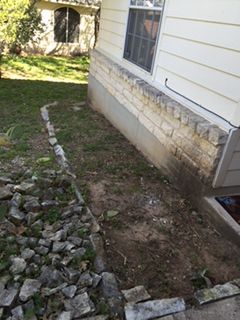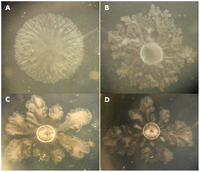Serena and Beth - Bacillus thurigiensis
Classification
[1]
Domain: Bacteria
Phylum: Firmicutes
Class: Bacilli
Order: Bacillales
Family :Bacillaceae
Species
|
NCBI: Taxonomy |
Bacillus
Habitat Information
This organism Bacillus thuringiensis was collected and isolated into a sample of 3 tablespoons of the dampen soil. It was gathered at the soil ground from a homeowner's front lawn on a street named Rei Tang Loop in Kyle, Texas, at the location Latitude: 30.0031643 and Longitude: -97.8756188 and Sea level: 221 m.
The collection laid within a sloped old garden patch that was within a stoned surrounding near a cactus plant and near a home dwelling.
The soil sample was collected on January 28th, 2016. The air temperature was 73 fahrenheit with humidity at 24 percent, with no rainfall prior to 24 hours, with solar radiation being at 2 of 10 UV. Soil was collected from the surface to the depth of 1 inch. The location was collected around 3:30 PM in a semi-shaded semi-sunny location with no foot traffic.
When the organism was observed in growth in an LB plate, at 37 celsius as it's incubated temperature for 168 hours, the organism grew rapidly.
Yet the prevalence of Bacillus thuringiensis is not restricted and has been isolated worldwide from many habitats, also including soil, stored-product dusts, insects, deciduous and coniferous leaves.
Description and Significance
Bacillus thuringiensis commonly known as Bt, was presented as a chosen soil sample and when isolated and grown in an LB agar plate, Bacillus thuringiensis colonies appeared irregular in shape, slightly umbonate, with smooth entire margins. Under the microscope the Bacillus thuringiensis after performing a Gram stain test results in being a Gram-positive organism, and is rod-shaped in nature and is approximately 1 µm in width and 5 µm in length. When a match patch test was done with 11 other soil samples, Bacillus thuringiensis showed clear evidence of clearing around the colony when grown on an LB plate that contained Staphylococcus aureus and / or Escherichia coli, Including of course the Bacillus thuringiensis itself. This is reason as to why this bacteria was hand pick to focus our studies on since in both scenarios, it suggested possible antimicrobial activity, despite it presenting it's own growth within another bacteria.
Genome Structure
[1]According to American Society for Microbiology , Genome Announcements the total number of predicted genes is 6,635, with 5,714 genes located on the chromosome and 921 genes on the plasmids.
Our PCR sequencing results are as follows:
Sequence 1
Forward:
The following information below contains the number of which was trimmed to eliminate all "N" results and as well as sequencing results.
5' bases trimmed: 19
3' bases trimmed:56
GACGGAGCAACGCCGCGTGAGTGATGAAGGCTT TCGNGGTCGTAAAACTCTGTTGTTAGGGAAGAACAAGTGCTAGTTGAATAAGCTGGCACCTTGACGGTACCTAACCAGAA AGCCACGGCTAACTACGTGCCAGCAGCCGCGGTAATACGTAGGTGGCAAGCGTTATCCGGAATTATTGGGCGTAAAGCGC GCGCAGGTGGTTTCTTAAGTCTGATGTGAAAGCCCACGGCTCAACCGTGGAGGGTCATTGGAAACTGGGAGACTTGAGTG CAGAAGAGGAAAGTGGAATTCCATGTGTAGCGGTGAAATGCGTAGAGATATGGAGGAACACCAGTGGCGAAGGCGACTTT CTGGTCTGTAACTGACACTGAGGCGCGAAAGCGTGGGGAGCAAACAGGATTAGATACCCTGGTAGTCCACGCCGTAAACG ATGAGTGCTAAGTGTTAGAGGGTTTCCGCCCTTTAGTGCTGAAGTTAACGCATTAAGCACTCCGCCTGGGGAGTACGGCC GCAAGGCTGAAACTCAAAGGAATTGACGGGGGCCCGCACAAGCGGTGGAGCATGTGGTTTAATTCGAAGCAACGCGAAGA ACCTTACCAGGTCTTGACATCCTCTGACAACCCTAGAGATAGGGCTTCTCCTTCGGGAGCAGAGTGACAGGTGGTGCATG GTTGTCGTCAGCTCGTGNCGTGAGATGTCATA
Sequence 2
Reverse:
The following information below contains the number of which was trimmed to eliminate all "N" results and as well as sequencing results.
5' bases trimmed: 12
3' bases trimmed: 26
ACCACCTGTCACTCTGCTCCCGAAGGAGAAGCCCTATCTCTAGGGTTGTCAGAGGATGTCAAGACCTGG TAAGGTTCTTCGCGTTGCTTCGAATTAAACCACATGCTCCACCGCTTGTGCGGGCCCCCGTCAATTCCTTTGAGTTTCAG CCTTGCGGCCGTACTCCCCAGGCGGAGTGCTTAATGCGTTAACTTCAGCACTAAAGGGCGGAAACCCTCTAACACTTAGC ACTCATCGTTTACGGCGTGGACTACCAGGGTATCTAATCCTGTTTGCTCCCCACGCTTTCGCGCCTCAGTGTCAGTTACA GACCAGAAAGTCGCCTTCGCCACTGGTGTTCCTCCATATCTCTACGCATTTCACCGCTACACATGGAATTCCACTTTCCT CTTCTGCACTCAAGTCTCCCAGTTTCCAATGACCCTCCACGGTTGAGCCGTGGGCTTTCACATCAGACTTAAGAAACCAC CTGCGCGCGCTTTACGCCCAATAATTCCGGATAACGCTTGCCACCTACGTATTACCGCGGCTGCTGGCACGTAGTTAGCC GTGGCTTTCTGGTTAGGTACCGTCAAGGTGCCAGCTTATTCAACTAGCACTTGTTCTTCCCTAACAACAGAGTTTTACGA CCCGAAAGCCTTCATCACTCACGCGGCGTTGCTCCGTCAGACTTTCGTCCATTGCGGAAGATTCCCTACTGCTGCCTCCC
Once given this information we entered this accordingly to BLAST , resulting in the most isolated soil organism was B.thiringiensis.
Cell Structure, Metabolism and Life Cycle
Bacillus thuringiensis forms parasporal crystals during the stationary phase of its growth cycle. Which it has two growth cycles vegetative cell division and spore development.
In the vegetative state it is rod shaped and presents into two daughter cells which happened midway of the plasma membrane.
Whereas, Sporulation,involves asymmetric cell division and is characterized by seven stages which include:
(stage I) axial filament formation (stage II) forespore septum formation (stage III) engulfment, first appearance of parasporal crystals and formation of a forespore (stages IV to VI) formation of exosporium, primordial cell wall, cortex and spore coats accompanied by transformation of the spore nucleoid (stage VII) spore maturation and sporangial lysis. [3]
Physiology and Pathogenesis
The Bacillus thuringiensis crystals which form on this bacterium are specifically toxic to certain orders and species of insects, like Lepidoptera, Diptera, and Coleoptera. Many different strains of Bacillus thuringiensis have been shown to produce these inclusions of insecticidal crystal protein (ICP). It also produces antibiotic compounds that have antifungal activity. Which is the likely case as to when grown in this soil project it seemed the most to have antimicrobial activity present. Bacillus thuringiensis is actually a form of pesticide that is naturally found within the soil that produces proteins that happen to be toxic to insect larvae. However different strains of Bacillus thuringiensis does exist and depending on the strain effects the insects differently. What happens when the insect digests this protein toxic ? [4] Well B. thuringiensis makes toxins that target insect larvae once eaten and digested,the toxins are activated. The activated toxin breaks down their gut,and the insects die of infection and starvation. Death then occurs within a few hours or weeks.
In contrast, when people eat the same toxins, the toxins are not activated and no harm occurs due to low in toxicity to people and other mammal and no evidence of sickness or infection as a result of exposure. Yet despite low toxicity the only known symptom a person that has been exposed to B. thuringiensis is within the products made with Bacillus thuringiensis which have caused eye and skin irritation. Yet there has been "one study, rats breathed in very high doses of concentrated Bt. Some had runny noses, crusty eyes, and goose bumps. Others were less active or lost weight." [4] "Researchers found also that farmworkers exposed for one to four months did not experience any problems related to their airways, nose, or skin. However, further exposure showed evidence of an immune response and the potential for skin allergies to develop."
Biochemical Lab results :
Motility : positive
Gram : positive
Capsule: positive
Phenol red : sucrose-red/no gas, glucose-yellow/no gas,lactose-red/ no gas
Starch hydrolysis: negative, no clearing
Casein hydrolysis: positive
Gelatin hydrolysis: positive
DNA hydrolysis(DNase): yellow with clearing and growth
Lipid hydrolysis: positive
Methyl red : red positive
VP: copper color, negative
Citirate test : green, negative
SIMs: S:negative I: positive(red lake) M: positive and turbid
Nitrate reduction: 1st step, no color 2nd step: positive
Urea hydrolysis: salmon in color
Triple sugar iron: red slant / yellow butt
Oxidase: negative
EMB: negative , no change
HE: negative ,no change
MAC: negative
deaminase : clear
Blood agar : beta complete clearing , alpha slight greenish hue
Catalase : no bubbles
MSA: growth ,no clearing
PEA: no clearing, growth
Antimicrobal sensitivity:A:little to no coloring , P:none
Disinfectant sensitivity: A,T,O: no change, dark yellow Ang:black
References
Author
Page authored by Serena Perez, student of Prof. Kristine Hollingsworth at Austin Community College.


